Coraline and Cycling
After visiting the Creative Arts exhibit at the California State Fair to see the knit/crochet entries and other art, we checked out the other halls. Every year there are special exhibits at the CA State Fair. Prior fairs featured machines and inventions, boating, Legos, candy, and toys. This year highlighted animation and cycling.
As you can imagine, the animation hall was FULL of people... many small people (not that there's anything wrong with that). They had a large merch section which I didn't care for, but the displays and information about the history of animation were interesting.
Here's one piece that I liked.
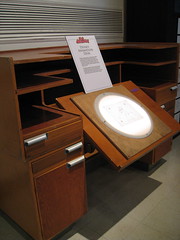
The Disney Animation Desk was designed by Kem Weber for the Walt Disney Studios. At the request of Walt, Weber set out to design a desk that would combine function with attractive modern design of the period. Just as important was his desire to promote the comfort of the animators by giving them a desk that eliminated unnecessary motion and strain. The lightboard enabled the animators to flip drawings and more easily observe the movement of the characters. By attaching the drawings at the bottom of the wheel, five drawings could be "rolled", permitting the artists to create the action of the characters and make corrections as required.
I spent a number of years looking at mask layouts on light tables and it was neat to see one of the first light tables even though this one was used for a different purpose.
Another area was dedicated to stop-motion animation and this scene was charming. To give you an idea of scale, the fox is about 8 inches tall.
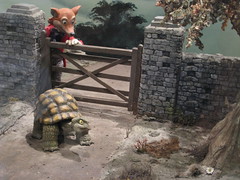
Tortoise & Hare set
Because none of the original sets for the film were saved, this one had to be painstakingly recreated to match the ones in the existing footage. Details such as texture on trees and structural elements like the fence were built from scratch. The 1952 era puppets had fared better, except for the Tortoise who required a new body. Their costumes were restored using vintage fabrics located in the Los Angeles garment district.
Coraline was there with some early conceptual drawings and character studies for her final look.
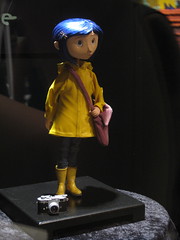
Coraline
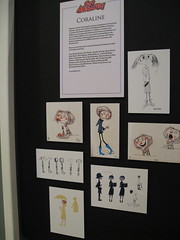
Coraline sketches and character studies
From there we moved on to the Cycling exhibit. This one was timely since I had just completed the Tour de Fleece which consisted of a lot of spinning while watching the Tour de France.
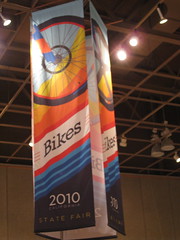
Bikes at the CA State Fair
The exhibit started out with early models made of wood, then moved on to the bikes made of metal. Bar none, these incarnations looked extremely uncomfortable, especially when you considered the types of roads they might have traveled on in the late-1700's to early-1800's.
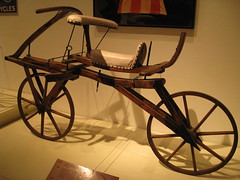
Early Velocipede
1791: French Nobleman, Comte Mede de Sivrac, named his masterpiece the Cheval de bois which translated means wooden horse. It was later named celeifere meaning dream of speed. This new invention could not actually be grouped into bicycle categories because of its lack of cycling parts. A rider had to turn the wheels by pushing his feet along the ground until it could be allowed to roll on its own.
1818: German Baron, Karl von Drais invents the first documented ancestor of the modern bicycle, unveiled in Paris as the draisine. This would later be known as the Hobby Horse. It was made entirely out of wood and had a steerable front wheel. Because they were difficult to balance on the rutted carriageway, the fad soon passed. It would be another 48 years before the bicycle idea was revisited.
Speaking of early vehicles powered by human feet pushing along the ground--
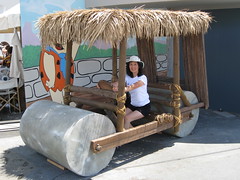
Fred & Wilma's sweet ride
But I digress... let us resume.
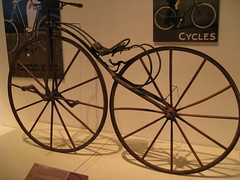
Bicycle from the 1800's
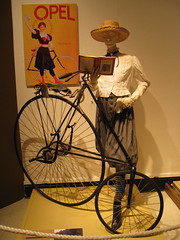
The New Woman
Bicycles were 3 times more energy efficient than walking and almost 4 times faster, encouraging an increased courting radius. but it was the 'safety' bike that gave women exceptional mobility and independence--powerful elements leading to their eventual emancipation. As bicycles became safer and less expensive, it because a symbol of 'The New Woman' of the 19th century and nicknamed the 'freedom machine' by feminists and suffragists. The bicycle craze lead to a drastic change in 'rational dress' for women, putting an end to the ankle-length skirt, corset, and bustle, and bringing about the then-shocking bloomers.
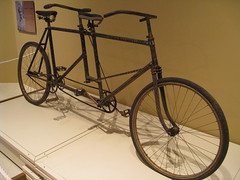
1897 Phoenix Tandem
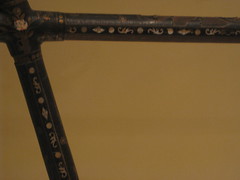
1897 Tandem Mother-of-Pearl detail:
Note the elegant cloisonne work and mother-of-pearl inlay. At one time, this bike was encrusted with gold plated handlebars. The dual steering system on this bike was common on tandems of that era.
Then we turned the corner and there were the modern bikes and 2 that had been ridden recently in the Tour de France. Very cool!

Greg LeMond rode this TVT bicycle with Campagnolo parts in the 1990 Tour de France competition, his third and final Tour de France victory.
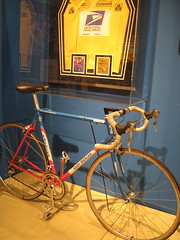
This frame set was used by Lance Armstrong at the 1993 Tour de France. It was on this frame that Armstrong rode his first Tour de France and where he captured the first Tour de France stage victory of his storied career. The jersey was worn on the podium by Lance Armstrong during the 2000 Tour de France.
Then there was bicycle art like this cycle made of glass--

Glassycle: The glass bicycle or "Glassycle" was created by Rene Steinke and dedicated to Matt Casto for the 2008 Amgen Tour of California. The Glassycle was produced from hand flame-worked borosilicate glass--a tedious process taking weeks to complete. Each step was precisely measured, heated, bent, joined, and cooled at calculated temperatures with the help of friends and skilled artists.
My favorite display was one of the last in the hall. The blue bike is just like one that R's family had when he was a kid.
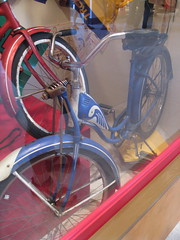
Bringing back memories
In the same display was a red Stingray--just like the bike that I rode when I was a kid (minus the streamers). How perfect is that?

My Schwinn
As you can imagine, the animation hall was FULL of people... many small people (not that there's anything wrong with that). They had a large merch section which I didn't care for, but the displays and information about the history of animation were interesting.
Here's one piece that I liked.

The Disney Animation Desk was designed by Kem Weber for the Walt Disney Studios. At the request of Walt, Weber set out to design a desk that would combine function with attractive modern design of the period. Just as important was his desire to promote the comfort of the animators by giving them a desk that eliminated unnecessary motion and strain. The lightboard enabled the animators to flip drawings and more easily observe the movement of the characters. By attaching the drawings at the bottom of the wheel, five drawings could be "rolled", permitting the artists to create the action of the characters and make corrections as required.
I spent a number of years looking at mask layouts on light tables and it was neat to see one of the first light tables even though this one was used for a different purpose.
Another area was dedicated to stop-motion animation and this scene was charming. To give you an idea of scale, the fox is about 8 inches tall.

Tortoise & Hare set
Because none of the original sets for the film were saved, this one had to be painstakingly recreated to match the ones in the existing footage. Details such as texture on trees and structural elements like the fence were built from scratch. The 1952 era puppets had fared better, except for the Tortoise who required a new body. Their costumes were restored using vintage fabrics located in the Los Angeles garment district.
Coraline was there with some early conceptual drawings and character studies for her final look.

Coraline

Coraline sketches and character studies
From there we moved on to the Cycling exhibit. This one was timely since I had just completed the Tour de Fleece which consisted of a lot of spinning while watching the Tour de France.

Bikes at the CA State Fair
The exhibit started out with early models made of wood, then moved on to the bikes made of metal. Bar none, these incarnations looked extremely uncomfortable, especially when you considered the types of roads they might have traveled on in the late-1700's to early-1800's.

Early Velocipede
1791: French Nobleman, Comte Mede de Sivrac, named his masterpiece the Cheval de bois which translated means wooden horse. It was later named celeifere meaning dream of speed. This new invention could not actually be grouped into bicycle categories because of its lack of cycling parts. A rider had to turn the wheels by pushing his feet along the ground until it could be allowed to roll on its own.
1818: German Baron, Karl von Drais invents the first documented ancestor of the modern bicycle, unveiled in Paris as the draisine. This would later be known as the Hobby Horse. It was made entirely out of wood and had a steerable front wheel. Because they were difficult to balance on the rutted carriageway, the fad soon passed. It would be another 48 years before the bicycle idea was revisited.
Speaking of early vehicles powered by human feet pushing along the ground--

Fred & Wilma's sweet ride
But I digress... let us resume.

Bicycle from the 1800's

The New Woman
Bicycles were 3 times more energy efficient than walking and almost 4 times faster, encouraging an increased courting radius. but it was the 'safety' bike that gave women exceptional mobility and independence--powerful elements leading to their eventual emancipation. As bicycles became safer and less expensive, it because a symbol of 'The New Woman' of the 19th century and nicknamed the 'freedom machine' by feminists and suffragists. The bicycle craze lead to a drastic change in 'rational dress' for women, putting an end to the ankle-length skirt, corset, and bustle, and bringing about the then-shocking bloomers.

1897 Phoenix Tandem

1897 Tandem Mother-of-Pearl detail:
Note the elegant cloisonne work and mother-of-pearl inlay. At one time, this bike was encrusted with gold plated handlebars. The dual steering system on this bike was common on tandems of that era.
Then we turned the corner and there were the modern bikes and 2 that had been ridden recently in the Tour de France. Very cool!

Greg LeMond rode this TVT bicycle with Campagnolo parts in the 1990 Tour de France competition, his third and final Tour de France victory.

This frame set was used by Lance Armstrong at the 1993 Tour de France. It was on this frame that Armstrong rode his first Tour de France and where he captured the first Tour de France stage victory of his storied career. The jersey was worn on the podium by Lance Armstrong during the 2000 Tour de France.
Then there was bicycle art like this cycle made of glass--

Glassycle: The glass bicycle or "Glassycle" was created by Rene Steinke and dedicated to Matt Casto for the 2008 Amgen Tour of California. The Glassycle was produced from hand flame-worked borosilicate glass--a tedious process taking weeks to complete. Each step was precisely measured, heated, bent, joined, and cooled at calculated temperatures with the help of friends and skilled artists.
My favorite display was one of the last in the hall. The blue bike is just like one that R's family had when he was a kid.

Bringing back memories
In the same display was a red Stingray--just like the bike that I rode when I was a kid (minus the streamers). How perfect is that?

My Schwinn
Labels: art, biking, California
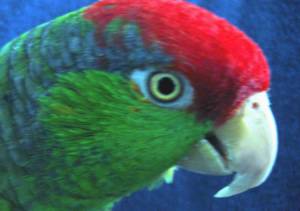
0 Comments:
Post a Comment
<< Home